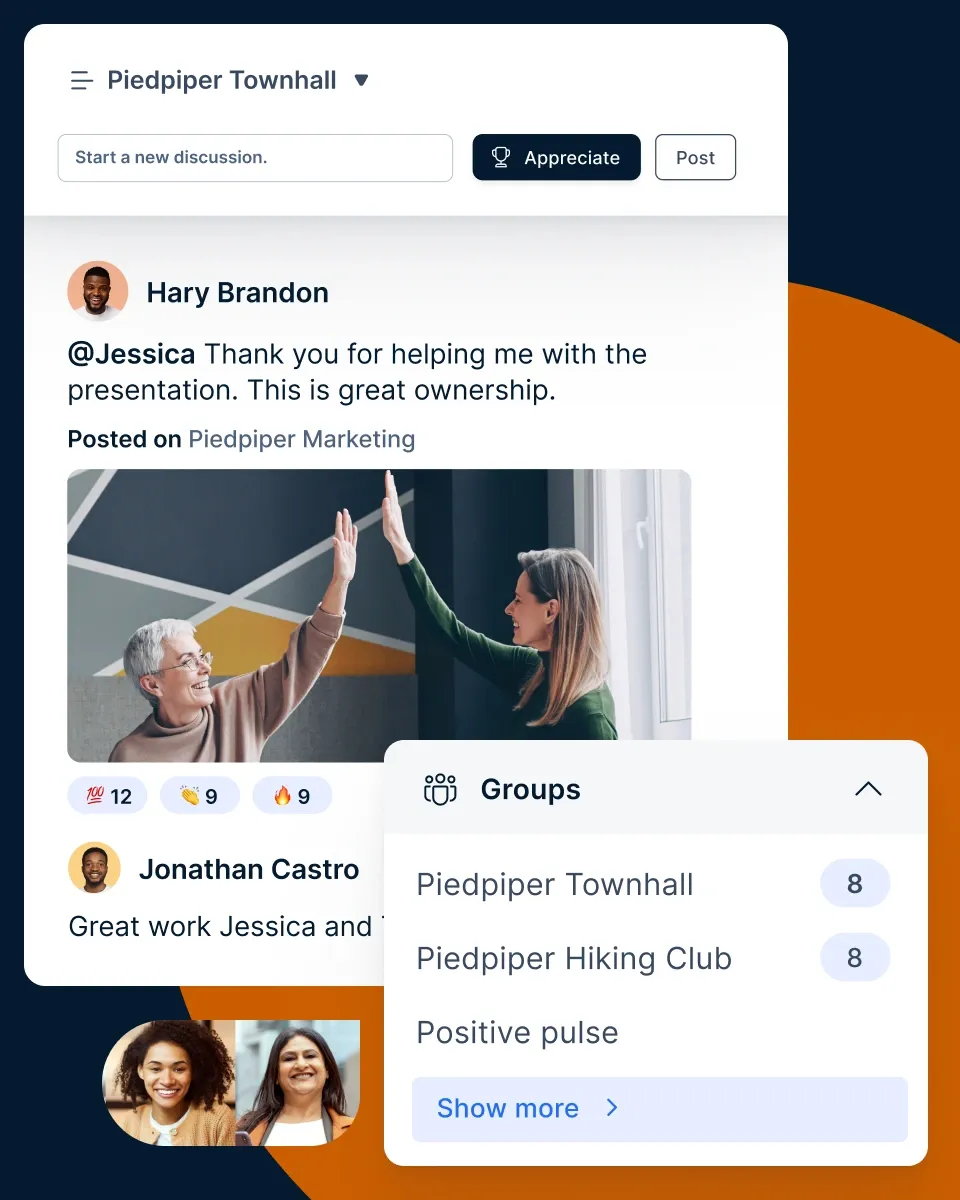Come ridurre l'assenteismo dei dipendenti: 7 strategie comprovate per un ambiente di lavoro produttivo
L'assenteismo dei dipendenti influisce sulla produttività, sul morale e sulle prestazioni aziendali. Questa guida spiega come ridurre l'assenteismo dei dipendenti con soluzioni pratiche per creare una forza lavoro più impegnata e affidabile.
In questa pagina
- Che cos'è l'assenteismo dei dipendenti?
- Esempi di assenteismo dei dipendenti
- Cause dell'assenteismo dei dipendenti
- Come misurare l'assenteismo dei dipendenti
- Come ridurre l'assenteismo dei dipendenti: 7 strategie efficaci
- Come ridurre al minimo l'assenteismo dei dipendenti
- Riducete l'assenteismo e costruite una forza lavoro più coinvolta con Empuls
- Conclusione
Ogni dipendente svolge un ruolo cruciale nella vostra organizzazione, sia che si tratti di un lavoratore entry-level o di un dirigente di alto livello. Il loro contributo fa sì che l'azienda funzioni senza intoppi, ma quando i dipendenti sono spesso assenti, la produttività, il morale e le operazioni complessive ne risentono. Secondo l'Ufficio Ufficio delle statistiche del lavoroil tasso di assenza per i lavoratori a tempo pieno è del 3,2%, il che evidenzia la crescente sfida dell'assenteismo sul posto di lavoro.
Sebbene un certo livello di assenze sia inevitabile - come vacanze programmate, emergenze personali o malattie occasionali - le assenze eccessive e non programmate creano notevoli disagi. L'assenteismo dei dipendenti può portare al mancato rispetto delle scadenze, all'aumento del carico di lavoro per gli altri e a perdite finanziarie. In effetti, ricerca dimostrano che l'assenteismo costa alle aziende 225,8 miliardi di dollari all'anno, con una media di 1.685 dollari per dipendente all'anno.
Quindi, come possono le organizzazioni affrontare questo problema?
In questo blog tratteremo le cause principali dell'assenteismo dei dipendenti, il suo impatto e le azioni da intraprendere per ridurre l'assenteismo dei dipendenti e creare un ambiente di lavoro che favorisca l'affidabilità, il coinvolgimento e la produttività.
Che cos'è l'assenteismo dei dipendenti?
Per assenteismo dei dipendenti si intende l'assenza abituale ed eccessiva dei dipendenti dal lavoro, al di là di ciò che è considerato normale o accettabile. A differenza dei giorni di malattia occasionali, delle ferie o delle emergenze impreviste - assenze che sono previste dalle politiche aziendali - l'assenteismo sul posto di lavoro comporta assenze frequenti e non programmate che interrompono il flusso di lavoro e incidono sulla produttività.
Se è inevitabile che i dipendenti manchino al lavoro a causa di malattie, emergenze familiari o obblighi personali, l'assenteismo dei dipendenti va oltre questi motivi legittimi. Si tratta di uno schema ricorrente di assenze non programmate, di arrivi in ritardo, di partenze anticipate o di interruzioni di intere giornate lavorative.
Con il tempo, questo modello influisce negativamente sulle prestazioni del team, aumenta il carico di lavoro per gli altri e mette a dura prova le operazioni aziendali complessive. Riconoscere e affrontare l'assenteismo è essenziale per mantenere una forza lavoro produttiva e impegnata.
Esempi di assenteismo dei dipendenti
Le ragioni per cui un dipendente può assentarsi regolarmente dal lavoro sono molteplici. Spesso ciò è dovuto al distacco dal proprio ruolo, ma possono esserci anche altri fattori sottostanti.
Alcuni esempi di assenteismo dei dipendenti sono:
- 🤒 Malattie o infortuni: Quando un dipendente è malato o infortunato, le visite mediche e la convalescenza possono essere motivo di assenteismo sul posto di lavoro.
- 💼 Ricerca di lavoro: Se un dipendente non è soddisfatto del lavoro attuale (per diversi motivi), può cercare altre opportunità di lavoro, perdendo il lavoro per partecipare ai colloqui di lavoro.
- 📅 O rari poco flessibili: Le organizzazioni che non permettono ai dipendenti di lavorare da casa occasionalmente tendono a registrare un alto tasso di assenteismo.
- 👶 Assistenza ai bambini e agli anziani: Un dipendente può assentarsi per molti giorni dal lavoro se non riesce a trovare un'assistenza alternativa per i propri figli o per gli adulti di cui è responsabile.
- 🧠 Malattia mentale: Secondo uno studio pubblicato sulla rivista NCBI (National Institute of Mental Health), la depressione è la principale causa di assenteismo.
- Disimpegno: I dipendenti che non sono più appassionati del proprio lavoro hanno maggiori probabilità di assentarsi per mancanza di motivazione.
- 😮💨 Burnout: I dipendenti sovraccarichi di lavoro possono ammalarsi a causa della mancanza di apprezzamento, stress elevatoo livelli di pressione elevati.
- 🥺 Molestie: I dipendenti che vengono costantemente presi di mira o individuati, sia da altri dipendenti che da dirigenti, sono più propensi ad assentarsi dal lavoro per sfuggire al mobbing.
- ⏰ F urto di tempo: Anche fare lunghe pause, arrivare in ritardo o uscire prima, invece di prendersi un'intera giornata di riposo, sono considerati assenteismo.
- 🧓 Età: In media, le persone più giovani hanno maggiori probabilità di perdere lavoro rispetto a quelle più anziane.
Cause dell'assenteismo dei dipendenti
Perché si verifica l'assenteismo dei dipendenti? Ci sono alcune cause comuni.
1. Scarso impegno dei dipendenti
I dipendenti che non sono impegnati nel loro lavoro non sono ispirati a fare il passo più lungo della gamba. Completano i loro compiti quotidiani con il minimo sforzo e poi tornano a casa. Il disimpegno sul lavoro non spinge le persone ad arrivare puntuali al lavoro e ad essere entusiaste ogni giorno, anzi, può incoraggiare un eccesso di assenze.
2. burnout sul posto di lavoro
Se i vostri dipendenti hanno troppe cose da fare ogni giorno e sembra che non riescano mai a riposare, alla fine si sentiranno esauriti. Il burnout sul posto di lavoro è un problema reale e crescente, soprattutto se la vostra azienda sta cercando di ridurre i costi non assumendo un numero sufficiente di lavoratori. Sebbene questo possa aiutare a risparmiare nel breve periodo, con il tempo i dipendenti si esauriranno e cominceranno a saltare il lavoro perché sono così sopraffatti.
3. Mancanza di flessibilità
Sebbene gli orari flessibili siano sempre più diffusi, molti datori di lavoro non li offrono. Questo può causare l'assenteismo dei dipendenti, che si trovano a dover bilanciare la propria vita, le priorità familiari e gli impegni lavorativi.
4. Molestie sul posto di lavoro
È logico che se i dipendenti non si sentono a proprio agio o al sicuro sul posto di lavoro, inizieranno a venire meno al lavoro. Le molestie possono essere verbali o fisiche (o entrambe) e possono provenire da superiori, dirigenti o colleghi. Questo fa sì che i dipendenti siano meno interessati al loro lavoro e che le loro prestazioni ne risentano.
Come misurare l'assenteismo dei dipendenti
Il monitoraggio dell'assenteismo dei dipendenti aiuta le organizzazioni a identificare i modelli, a valutare l'impatto sulla produttività e a implementare strategie efficaci di riduzione dell'assenteismo. Il metodo più comune per misurare l'assenteismo è la formula del tasso di assenteismo, che calcola la percentuale di giorni lavorativi persi a causa di assenze non programmate.
Formula del tasso di assenteismo
Tasso di assenteismo= ( Totale assenze non giustificate / Totale giorni lavorativi )×100
- Totale assenze non giustificate: Il numero di giorni in cui un dipendente è stato assente senza previa autorizzazione (esclusi i permessi programmati come le ferie e i congedi medici).
- Giorni di lavoro totali: Il numero totale di giorni lavorativi programmati in un determinato periodo.
Ad esempio, se un dipendente è stato assente per 5 giorni non pianificati in un mese con 20 giorni lavorativi, il tasso di assenteismo sarebbe:
(5/20)×100=25%
Ulteriori metriche per monitorare l'assenteismo sul posto di lavoro
- Tasso di ritardo: Misura la frequenza degli arrivi in ritardo e delle partenze anticipate.
- Frequenza delle assenze: Tiene traccia della frequenza con cui un dipendente prende permessi non programmati in un determinato periodo.
- Durata delle assenze: Analizza la durata media delle assenze per individuare le tendenze dell'assenteismo a breve termine rispetto a quello a lungo termine.
Perché misurare l'assenteismo è importante
La comprensione delle tendenze dell'assenteismo consente alle aziende di affrontare le cause sottostanti, di attuare strategie per ridurre l'assenteismo dei dipendenti e di creare un ambiente di lavoro favorevole che incoraggi la presenza e garantisca il benessere dei dipendenti.
Come ridurre l'assenteismo dei dipendenti: 7 strategie efficaci
La gestione dell'assenteismo dei dipendenti non si limita all'applicazione delle politiche di presenza. I datori di lavoro devono affrontare le cause principali, creare un ambiente di lavoro favorevole e attuare strategie che incoraggino i dipendenti a essere presenti e impegnati. Ecco sette modi comprovati per ridurre l'assenteismo sul posto di lavoro e migliorare la soddisfazione generale dei dipendenti.
1. Identificare le cause principali dell'assenteismo
Il primo passo per ridurre l'assenteismo è capire perché i dipendenti si assentano spesso. Le assenze possono derivare da problemi sul posto di lavoro, da problemi personali o da un mix di entrambi. La conduzione di indagini di feedback sui dipendenti può aiutare a scoprire gli schemi e a individuare le aree da migliorare.
Per i dipendenti che rientrano da un congedo prolungato, come quello di maternità o di malattia, un colloquio di ritorno al lavoro può facilitare la transizione e garantire che siano pronti a riprendere le loro responsabilità. Mantenere aperta la comunicazione e affrontare le preoccupazioni in modo proattivo favorisce una forza lavoro più impegnata.
2. Personalizzare le soluzioni per i diversi team
L'assenteismo non colpisce tutti i reparti allo stesso modo e raramente una soluzione unica funziona. I diversi team possono avere problemi diversi: ciò che influisce su un team di marketing può non essere lo stesso che causa l'assenteismo nell'assistenza clienti.
Ad esempio, se i dipendenti di un servizio clienti sono molto stressati, l'offerta di pause più lunghe o di strumenti di assistenza automatizzati può ridurre il burnout. Se un team di marketing è alle prese con assenze dovute a scadenze irrealistiche, la soluzione migliore può essere migliorare la comunicazione e le tempistiche dei progetti. Le soluzioni personalizzate in base alle esigenze del team garantiscono un approccio più efficace.
3. Attuare programmi di benessere sul posto di lavoro
Un solido programma di benessere per i dipendenti può ridurre significativamente l'assenteismo sul posto di lavoro affrontando il tema del benessere fisico, emotivo e mentale. I dipendenti che si sentono supportati nella gestione dello stress e nel mantenimento di un buono stato di salute hanno maggiori probabilità di presentarsi sul posto di lavoro e di ottenere buoni risultati.
Le iniziative di benessere possono includere:
- Risorse per la salute mentale, come sessioni di terapia o workshop sulla gestione dello stress.
- Incentivi per il fitness, come iscrizioni a palestre o sfide di passi
- Opzioni di snack salutari e postazioni di lavoro ergonomiche per promuovere il benessere fisico
Dando priorità alla salute dei dipendenti, le organizzazioni possono ridurre le assenze dovute allo stress e migliorare il coinvolgimento generale.
4. Offrire permessi retribuiti e orari flessibili
I dipendenti che sentono di avere un tempo di riposo adeguato sono meno propensi a fare assenze non programmate. Offrire congedi retribuiti per malattia, maternità/paternità e permessi personali consente ai dipendenti di riposare quando necessario, prevenendo l'esaurimento e il disimpegno a lungo termine.
Durante i picchi influenzali o le crisi sanitarie come la COVID-19, l'offerta di congedi retribuiti per malattia garantisce che i dipendenti possano riprendersi senza diffondere la malattia sul posto di lavoro. Questo approccio proattivo è vantaggioso sia per i dipendenti che per l'azienda, in quanto mantiene una forza lavoro più sana.
5. Privilegiare l'equilibrio tra lavoro e vita privata con orari flessibili.
Un orario di lavoro rigido può contribuire all'assenteismo dei dipendenti, soprattutto per coloro che devono gestire obblighi familiari, lunghi spostamenti o sfide personali. Le aziende che consentono orari di lavoro flessibili, opzioni di lavoro a distanza o persino una settimana lavorativa di quattro giorni spesso registrano un miglioramento della presenza e della produttività.
Con la tecnologia che facilita la collaborazione a distanza, le aziende possono adattarsi ai moderni stili di lavoro mantenendo i dipendenti impegnati. Un ambiente di lavoro flessibile dimostra ai dipendenti che il loro benessere è importante, rendendoli più impegnati nel loro ruolo.
6. Riconoscere e premiare i contributi dei dipendenti
Il morale basso e la mancanza di motivazione sono i principali fattori che contribuiscono all'assenteismo. Quando i dipendenti si sentono sottovalutati, sono meno propensi a essere presenti e impegnati. I programmi di riconoscimento dei dipendenti possono aumentare il morale e rafforzare una cultura di apprezzamento.
I modi per riconoscere i dipendenti includono:
- Premiare coloro che hanno un eccellente registro di presenze
- Riconoscere pubblicamente i membri del team per il loro duro lavoro.
- Inviare e-mail di apprezzamento, biglietti di ringraziamento o piccoli segni di gratitudine.
- Organizzazione di attività di team-building o eventi celebrativi
Un ambiente di lavoro che celebra i risultati e promuove il senso di appartenenza incoraggia i dipendenti a impegnarsi e a presentarsi con costanza.
7. Promuovere una cultura della comunicazione e della collaborazione
La creazione di un ambiente di lavoro in cui i dipendenti si sentano ascoltati e valorizzati svolge un ruolo fondamentale nella riduzione dell'assenteismo dei dipendenti. Quando i dipendenti si fidano dei loro manager e si sentono legati ai loro colleghi, è più probabile che si impegnino e si presentino con costanza.
Incoraggiare la collaborazione:
- Promuovere discussioni aperte tra i team e la leadership
- Costruire un ambiente di lavoro diversificato e inclusivo che supporti le diverse prospettive
- Stabilire un ambiente psicologicamente sicuro in cui i dipendenti possano esprimere le proprie preoccupazioni senza temere ritorsioni.
- Affrontare i conflitti sul posto di lavoro in modo proattivo per mantenere un'atmosfera positiva.
I dipendenti che si sentono rispettati e coinvolti nel processo decisionale hanno maggiori probabilità di rimanere impegnati, riducendo la probabilità di assenteismo.
Come ridurre al minimo l'assenteismo dei dipendenti
La quantità di assenteismo che un'azienda o un'organizzazione può tollerare varia da dipendente a dipendente, da azienda ad azienda e, talvolta, dal periodo dell'anno.
Una delle chiavi principali per ridurre l'assenteismo è garantire che la politica sulle presenze sia chiara e compresa da tutti i dipendenti attuali e dai nuovi assunti.
I datori di lavoro possono anche scoraggiare i dipendenti dall'assentarsi adottando misure proattive come:
- Premiare le buone presenze
- Fornire un supporto emotivo e fisico alla salute
- Concentrarsi sull'equilibrio tra lavoro e vita privata
- Creare un orario flessibile
- Opportunità di lavorare da casa
- Mantenere aperta la comunicazione
- Incoraggiare la collaborazione
- Richiedere periodicamente un feedback
- Ridurre lo stress sul posto di lavoro
- Avere una chiara politica di presenza
Riducete l'assenteismo e costruite una forza lavoro più coinvolta con Empuls
Il frequente assenteismo è spesso sintomo di un problema più profondo: il disimpegno. I dipendenti che si sentono non ascoltati, non riconosciuti o scollegati dal loro posto di lavoro sono più propensi a prendere assenze non programmate, con un impatto sulla produttività e sul morale.
Per ridurre veramente l'assenteismo, le organizzazioni hanno bisogno di qualcosa di più di semplici politiche di presenza; hanno bisogno di una cultura che mantenga i dipendenti impegnati, apprezzati e motivati a presentarsi. È qui che Empuls fa la differenza.
Come Empuls aiuta a stimolare il coinvolgimento e a ridurre l'assenteismo:
1. Trasforma il feedback in azione

I dipendenti non hanno solo bisogno di una voce, ma di essere ascoltati. Con strumenti di feedback strutturati per i dipendentile aziende possono scoprire le vere ragioni dell'assenteismo, affrontare i problemi prima che si aggravino e creare un ambiente in cui i dipendenti si sentano sostenuti.
2. Il riconoscimento diventa una pratica quotidiana

Le persone non si disimpegnano da un giorno all'altro, ma quando sentono che i loro sforzi passano inosservati. Un forte programma di programma di premi e riconoscimenti fa sì che i dipendenti si sentano apprezzati per il loro contributo, aumentando la motivazione e riducendo la voglia di assentarsi inutilmente.
3. Crea un ambiente di lavoro di cui i dipendenti vogliono far parte.

L'assenteismo non è solo un'assenza fisica, ma anche un distacco emotivo. Un ambiente di lavoro collaborativo e ambiente di lavoro sociale favorisce le connessioni, rafforza i rapporti di squadra e dà ai dipendenti un senso di appartenenza che li spinge a presentarsi ogni giorno.
4. Favorisce l'equilibrio tra lavoro e vita privata senza perdita di produttività

Il burnout e l'esaurimento portano spesso all'assenteismo. Empuls aiuta le organizzazioni a implementare programmi di benessere, premi milestone e politiche di lavoro flessibili, consentendo ai dipendenti di ricaricarsi senza sentirsi disconnessi dal lavoro.
Un'azienda che dà priorità al coinvolgimento, al riconoscimento e alla comunicazione non deve lottare contro l'assenteismo: diminuisce naturalmente. Con Empuls, le organizzazioni non si limitano a monitorare le presenze, ma creano un ambiente di lavoro in cui i dipendenti vogliono stare, garantendo una maggiore fidelizzazione, una migliore produttività e una forza lavoro più felice.
Siete pronti a trasformare il vostro posto di lavoro? Iniziate a usare Empuls oggi stesso!
Conclusione
Quando i dipendenti sono assenti, aumentano la pressione e il carico di lavoro degli altri. Non solo, crea anche un costo maggiore per il datore di lavoro. In caso di assenze eccessive, l'azienda potrebbe attivarsi per trovare dei sostituti o magari pagare degli straordinari ad altri per coprire temporaneamente il dipendente assente.
Se la retribuzione degli straordinari costa di più al datore di lavoro, questo può ridurre significativamente i profitti e aumentare il costo del lavoro per il datore di lavoro.
Quando c'è un ambiente in cui i dipendenti non vogliono assentarsi, è più probabile che siano presenti. Creare un ambiente sano e stabile per i dipendenti è il modo migliore per ridurre l'assenteismo sul posto di lavoro.













